Bathroom Readers' Institute's Blog, page 114
April 1, 2015
The Best Pranks Ever
Don’t look now, but your fly is open. Ha ha—April Fool’s!
Give Me Tacos or Give Me Death!
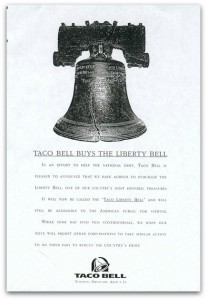 In 1996 the fast-food chain Taco Bell issued a brief statement announcing its purchase of the Liberty Bell. According to the press release, Taco Bell was responding to an inquiry from the U.S. government about the possibility of reducing the national debt by selling off its national treasures to corporations. Taco Bell thought the Liberty Bell would make the ideal company logo. In fact, they planned to rename it the Taco Liberty Bell. Then, just a few hours after the announcement, Taco Bell quietly issued a retraction, saying the whole thing had been a big joke. But by that time, the story had been widely reported by the news media. At a press briefing the next day, White House press secretary Mike McCurry was bombarded by hostile reporters who hadn’t yet heard the whole thing was a hoax. “We will also be selling the Lincoln Memorial to Ford Motor Company,” McCurry said, “and renaming it the Lincoln-Mercury Memorial.”
In 1996 the fast-food chain Taco Bell issued a brief statement announcing its purchase of the Liberty Bell. According to the press release, Taco Bell was responding to an inquiry from the U.S. government about the possibility of reducing the national debt by selling off its national treasures to corporations. Taco Bell thought the Liberty Bell would make the ideal company logo. In fact, they planned to rename it the Taco Liberty Bell. Then, just a few hours after the announcement, Taco Bell quietly issued a retraction, saying the whole thing had been a big joke. But by that time, the story had been widely reported by the news media. At a press briefing the next day, White House press secretary Mike McCurry was bombarded by hostile reporters who hadn’t yet heard the whole thing was a hoax. “We will also be selling the Lincoln Memorial to Ford Motor Company,” McCurry said, “and renaming it the Lincoln-Mercury Memorial.”
Paper Trail
The English paper manufacturer Donside holds an annual contest for graphic design students. The theme of the contest in 2000 was “Tell a Lie Convincingly,” using paper in some way. After hundreds of entries had been sent in, the participating schools received a letter from Donside Paper stating that the contest had been called off. Disappointed design students all over England began calling Donside to complain. But it turned out Donside hadn’t cancelled the contest. The letter was a prank…or a very clever contest entry. Just as Donside scrambled to get the contest back underway, students received another notice: the final deadline had been moved up. Entrants rushed to get their projects in on time, completely unaware that they’d been fooled again. Who sent the letters? No one knows. Despite the fact that the Donside Paper Company announced that they wouldn’t punish the culprits and even offered to judge the pranks as contest entries, nobody ever came forward to claim responsibility for them.
A Monumental Hoax
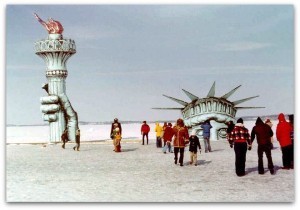 Every student election seems to have a joke candidate, and the 1979 student body president election at the University of Wisconsin was no exception. Jim Mallon and Leon Varjian campaigned on a unique platform: to purchase and relocate the Statue of Liberty to Madison, Wisconsin. Amazingly, they won. But voters didn’t take the pledge seriously—Mallon and Varjian couldn’t actually pull the stunt off. Or could they? One winter morning, the instantly recognizable head and torch of the Statue of Liberty appeared, poking out from nearby Lake Mendota. Varjian told the UW student paper that he and Mallon tried to fulfill their campaign promise—but the cable transporting the statue via helicopter broke and, tragically, dropped the statue, partially submerging it. It wasn’t the real statue, of course—it was plywood papier-mâché and chicken wire; Mallon and Varjian had been secretly overseeing its construction for months. (The two insisted that it was the real Statue of Liberty.) The student newspaper later revealed that $4,500 of student money had been used to make the statue. Mallon and Varjian’s response: they offered to write a check to any interested student for their individual share of wasted funds—10¢ each. The statue was destroyed by unknown arsonists three weeks later, but the prankster duo won again next year and rebuilt the statue (this time they spent $6,000). That one was removed by the Wisconsin Department of Natural Resources. It now lives in a shed on campus.
Every student election seems to have a joke candidate, and the 1979 student body president election at the University of Wisconsin was no exception. Jim Mallon and Leon Varjian campaigned on a unique platform: to purchase and relocate the Statue of Liberty to Madison, Wisconsin. Amazingly, they won. But voters didn’t take the pledge seriously—Mallon and Varjian couldn’t actually pull the stunt off. Or could they? One winter morning, the instantly recognizable head and torch of the Statue of Liberty appeared, poking out from nearby Lake Mendota. Varjian told the UW student paper that he and Mallon tried to fulfill their campaign promise—but the cable transporting the statue via helicopter broke and, tragically, dropped the statue, partially submerging it. It wasn’t the real statue, of course—it was plywood papier-mâché and chicken wire; Mallon and Varjian had been secretly overseeing its construction for months. (The two insisted that it was the real Statue of Liberty.) The student newspaper later revealed that $4,500 of student money had been used to make the statue. Mallon and Varjian’s response: they offered to write a check to any interested student for their individual share of wasted funds—10¢ each. The statue was destroyed by unknown arsonists three weeks later, but the prankster duo won again next year and rebuilt the statue (this time they spent $6,000). That one was removed by the Wisconsin Department of Natural Resources. It now lives in a shed on campus.
For more pranks—and literally hundreds of other topics, check out the book where this article originated , Uncle John’s Slightly Irregular Bathroom Reader.
The post The Best Pranks Ever appeared first on Trivia Books and Facts | Uncle John's Bathroom Reader.
March 31, 2015
HAPPY EOSTRE!
Ever wonder why a sacred Christian holiday is celebrated with candy, baskets, and a bunny?
 The Holiday
The HolidayBefore Christianity, early Germans held an annual celebration in honor of Eostre, goddess of spring and fertility. As Christianity spread across Europe in the first and second centuries, the Church often modified or adopted pagan holidays. Because Eostre was the goddess of spring and her festival celebrated renewal and rebirth, the Church’s belief in Christ’s resurrection made for a good match.
The Easter Bunny
Rabbits breed notoriously quickly. Eostre’s association with fertility led to her frequent depiction with a rabbit’s head. But the concept of an Easter Bunny originated with the Germans, who settled in Pennsylvania when they emigrated to the United States in the 1700s. Their “Pennsylvania Dutch” children believed that if they were well-behaved, the Oschter Haws (literally, “Easter rabbit”) would leave a nest of brightly colored eggs on Easter morning. The idea began to catch on nationwide after the Civil War.
Easter Eggs
In a folktale, Eostre turns her pet bird into a rabbit to entertain some children. The rabbit performs a trick: it lays colorful eggs. Eggs are also a common symbol of rebirth in many ancient cultures, including those of Egypt, Persia, China, Gaul, and Rome. The first concrete historical association of colored eggs with Easter is in the 1200s, when English servants were given painted eggs by their masters as Easter gifts.
Easter Sunday
In the early years of Christianity, Easter was an informal holiday, celebrated sometime in the spring. Early Christians were widely persecuted and could not worship openly, but conditions eased when Constantine became the first Roman emperor to convert to Christianity. In 325 A.D., he issued an edict: Easter was to be celebrated on the first Sunday after the first full moon after the vernal equinox (the first day of spring). According to that schedule, Easter will always fall on the same weekend as Passover, the time when Christ was condemned. Linking Passover, Easter, and the vernal equinox ensures that Easter will be on a Sunday between March 22 and April 25 every year.
Easter Baskets
This is also from the “Pennsylvania Dutch” Germans. Children would build a little “nest” and leave it overnight somewhere in the yard or home for the Oschter Haws to lay it’s colored eggs in. This eventually evolved into the brightly colored baskets of eggs and candy we have today.
For more on Easter—and literally hundreds of other topics, check out the book where this article originated , Uncle John’s Slightly Irregular Bathroom Reader.
The post HAPPY EOSTRE! appeared first on Trivia Books and Facts | Uncle John's Bathroom Reader.
March 26, 2015
10 Random Trivia Facts about $2 Bills
Random trivia facts about the least-popular denomination of U.S. currency: the $2 bill.. Story originally published in
Uncle John’s Perpetually Pleasing Bathroom Reader
.
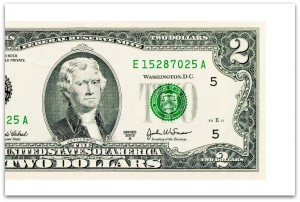 First authorized in 1862, $2 bills were printed until 1966, at which point they were discontinued…but only for 10 years. They were reintroduced in 1976 as part of the Bicentennial celebration.
First authorized in 1862, $2 bills were printed until 1966, at which point they were discontinued…but only for 10 years. They were reintroduced in 1976 as part of the Bicentennial celebration.Many collectors had their Bicentennial bills postmarked on the day of issue (April 13, 1976), hoping to turn them into valuable collectibles. There are now so many of the postmarked bills that they may never be worth more than $2.
The 1976 reintroduction was an attempt at cost-cutting. The government estimated that it could save $26 million if the $2 bill replaced about half of the $1 bills in circulation. (It didn’t.)
Because of a persistent myth that $2 bills are no longer in production, some people hoard them. According to the U.S. Treasury, there are about 500 million $2 bills in circulation.
In 1925, the U.S. government tried to promote the use of $2 bills by putting one in all federal-employee pay envelopes.
Who’s on the $2 bill? It’s been Thomas Jefferson since 1869. But when the bill was introduced in 1862, it featured Alexander Hamilton’s portrait.
When you pay for something with a $2 bill, where does the cashier put it? Under the cash drawer. Reason: There’s no standard slot for $2 bills.
Merchants sometimes refuse to accept $2 bills, and that’s perfectly legal. They could turn down $20s, too. In fact, if they prefer credit card or electronic payment, they aren’t legally required to accept cash at all, regardless of denomination.
Less than one percent of U.S. currency produced is $2 bills.
In 2005 a man in Baltimore, Maryland, purchased a car radio from Best Buy and tried to pay the $114 installation fee with 57 $2 bills. The store manager was suspicious of the bills and called the police, who detained Mike Bolesta for three hours (in handcuffs) while they brought in the Secret Service to determine whether the bills were genuine. (They were.)
The post 10 Random Trivia Facts about $2 Bills appeared first on Trivia Books and Facts | Uncle John's Bathroom Reader.
Impossible Questions: Angels in the Airwaves Edition (The Answer!)
Think you’ve got the right answer? Keep reading to see if you nailed it.
What strange medical condition do Weird Al Yankovic’s 1989 movie UHF and the 1999-2004 UPN supernatural drama Angel have in common?
Bell’s palsy is a temporary form of facial paralysis, generally affecting a small area of the face, or as much as half. A nerve in the brain stops firing (scientists aren’t sure why, but many believe a virus is to blame), so the brain cannot control facial muscles for as long as a few weeks. The condition almost always clears up on its own over time.
An actor’s instrument is their face, and when an actor gets Bell’s palsy, it can certainly cause problems if they’re in the middle of a production. This happened on both the set of the movie UHF and the TV series Angel.
After starring in a dozen comic music videos and hosting specials on MTV, Yankovic made a movie called UHF in 1989. The plot: a man inherits a small TV station and airs bizarre programs, including Stanley Spadowski’s Clubhouse, a kid’s show hosted by the station’s manchild janitor. Michael Richards played Stanley, just before he’d become a star as Kramer on Seinfeld. But he almost had to turn down the role. Just before filming, he contracted Bell’s palsy, and half of his face was frozen. He called Yankovic to resign, who wouldn’t hear it—he thought a half-frozen face would be a fine addition to his already odd character. Richards ultimately saw an acupuncturist, who he says made the palsy disappear in two days, and filming was unaffected.
In 2004, just before filming was to start on the fifth season of Angel, a supernatural drama about a vampire and his cohorts taking over a lawfirm run by demons, co-star Alexis Denisof was diagnosed with Bell’s palsy. The left side of his face was paralyzed, requiring Angel producers to devise new ways of filming him, to avoid showing his unmoving face. It also made writers have to reconsider Wesley Wyndam-Price, his character. Often a manic, high-strung source of comic relief, writers were forced to make Wesley more pensive, brooding, and quiet. (The palsy went away, but the character traits remained.)
Want more impossible questions? Check out Uncle John’s Impossible Questions.
The post Impossible Questions: Angels in the Airwaves Edition (The Answer!) appeared first on Trivia Books and Facts | Uncle John's Bathroom Reader.
March 25, 2015
Impossible Questions: Angels in the Airwaves Edition
Think you know the answer to this question? Think you can get it? Good luck…and come back tomorrow to see if you’re right.
What strange medical condition do Weird Al Yankovic’s 1989 movie UHF and the 1999-2004 UPN supernatural drama Angel have in common?
Want more impossible questions? Check out Uncle John’s Impossible Questions.
The post Impossible Questions: Angels in the Airwaves Edition appeared first on Trivia Books and Facts | Uncle John's Bathroom Reader.
History of The Masters
This week in 1934, golfer Horton Smith won the first ever Masters golf tournament. From Uncle John’s Bathroom Reader Tees off on Golf , here’s a look at the storied and tumultuous history of “the Super Bowl of Golf.”
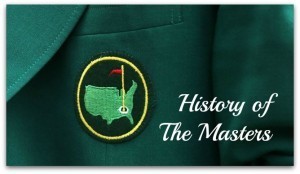 GRAND DESIGN
GRAND DESIGNBobby Jones was one of the best golfers ever to play the game. A refined gentleman from a wealthy Southern family, Jones never turned pro—he considered playing golf for money beneath his social station. Yet, despite his amateur status, he dominated golf throughout the 1920s. In 1930 he won what was then considered golf’s Grand Slam, with victories in the U.S. Open, British Open, U.S. Amateur, and British Amateur. With the Grand Slam under his belt, that same year Jones decided—at the ripe old age of 28—to retire from competitive golf and turn his sights toward building his dream golf course. With a handful of rich cronies, he purchased 365 acres outside of Augusta, Georgia, and formed one of the most exclusive country clubs in America: the Augusta National Golf Club.
MAGNOLIA LANE
From the beginning, Augusta National, as it is now known, was dedicated to an upper-class vision of the golfing life. Only the richest and most influential businessmen (emphasis on men—only three women have ever been members of the club) were invited to apply for membership. The club’s most famous member: Dwight D. Eisenhower, who visited Augusta regularly before, during, and after his presidency.
Jones and his buddies wanted the grounds of their new club to reflect its high-class membership. With that in mind, they hired acclaimed English golf course architect Dr. Alister Mackenzie to design it. And under his hand, landscaping at Augusta National became an art form. Magnolia trees and azaleas planted back in the 1850s—when the property belonged to a Belgian baron with a taste for expensive horticulture—gave them a head start. By the time the course opened in 1932, the clubhouse, grounds, and the links themselves looked like a museum replica of plantation days in the Old South.
THE AUGUSTA NATIONAL INVITATIONAL
With the best golf course money could buy, it was only natural that the club members would want to host a major tournament. After a deal to host the 1933 U.S. Open fell through, they decided to inaugurate their own annual tournament. The first one was held in the spring of 1934 and was called the Augusta National Invitational Tournament (the name wouldn’t be changed to the Masters until 1939).
Bobby Jones was such an important figure in the golfing world that he had no trouble convincing the game’s greatest players to come play at Augusta. Byron Nelson, Jimmy Demaret, Ben Hogan, and Sam Snead were among the legendary players who won early Masters tournaments and helped give the event the credibility it now enjoys. Both Arnold Palmer and Jack Nicklaus mastered the course— they hold ten Masters titles between them. Their rivalry during the 1960s focused world attention on Augusta National and added to its legend.
THE GREEN JACKET
The membership of Augusta National has always been obsessed with tradition. In 1937 club members began wearing green jackets that bore the club crest to distinguish themselves from common fans. When Sam Snead won the first of his three Masters titles in 1949, he was presented with his own honorary club jacket—and a new tradition was born. Every year since then, the new champion has been given a green jacket by the previous year’s winner. Having won the Masters, the champion gets to take his green jacket home with him for a year. After that, he is given a locker in the exclusive Champions Locker Room, where his jacket will be waiting for him whenever he returns to Augusta.
Along with the green jacket, Masters winners receive a lifetime exemption from qualifying for future tournaments. In other words, once a golfer has won the Masters, he is welcome to come back and play every year for the rest of his life—he has a permanent invitation. Many golfing legends have taken advantage of this clause, returning to Augusta every spring, even long after their game has passed its prime. Arnold Palmer played his 50th consecutive Masters in 2004 (he hadn’t made the cut since 1983).
Older past champions traditionally start off the tournament by ceremonially hitting the first ball.
CONTROVERSY BENEATH THE PINES
The Old South traditions that have been so key to the tournament’s prestige have also been the source of much of its negative publicity. Some of Augusta National’s traditions are of the sort that antidiscrimination laws were designed to stop. The darkest chapter of the PGA’s history was the organization’s failure to issue tour cards to black golfers until 1961. Even then, the Masters lagged behind the rest of the golf world. Any player who wins a Tour event is supposed to receive an automatic invitation to the next year’s Masters. But black golfers like Charlie Sifford found that their wins didn’t count with the Masters invitation committee. They were not invited. In 1973, 18 members of Congress wrote to Augusta National to express concern over their policies, but the club ignored them. Finally, in 1975 Lee Elder became the first black golfer to play at Augusta after winning the Monsanto Open. Elder may have integrated the tournament, but no African American was invited to apply for membership in the club itself until 1990.
A GENTLEMAN’S GAME
Although the Masters is, to many golfers, the most important professional tournament on the PGA Tour, Augusta National still honors the principles of amateurism as exemplified by the life and career of Bobby Jones. Five spots in the tournament are held aside for the best amateur players: the winner and runner-up of the U.S. Amateur; the winner of the British Amateur; the winner of the U.S. Amateur Public Links tournament; and the champion of the U.S. Mid- Amateur tournament. The top floor of the Augusta National clubhouse is called the Crow’s Nest and is used to provide housing for amateur players during the tournament. In the old days, when amateur events were a more important part of big-time golf, they needed bunk beds to house all of the young players staying in the Crow’s Nest. These days, there are only five beds.
The post History of The Masters appeared first on Trivia Books and Facts | Uncle John's Bathroom Reader.
March 24, 2015
How Did the First Candidate Do?
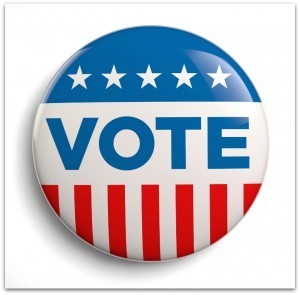 Republican senator Ted Cruz this week announced his candidacy for president—the first major declared candidate in the 2016 election. Here’s a look back at the early candidates in previous presidential election.
Republican senator Ted Cruz this week announced his candidacy for president—the first major declared candidate in the 2016 election. Here’s a look back at the early candidates in previous presidential election.
2012
Herman Cain, a businessman best known as the CEO of Godfather’s Pizza, formed a presidential campaign exploratory committee in Jan. 2011. Although he won two straw polls, the Republican nominee dropped out of the race on Dec. 2011.
2008
North Carolina senator John Edwards, who ran as vice president on the Democratic ticket in 2004, was the first major nominee to declare his candidacy. He announced from his home in New Orleans in Dec. 2006. After losing to Barack Obama and Hillary Clinton in every primary and caucus, Edwards dropped out in Jan. 2008.
2004
Popular Republican president George W. Bush didn’t face any challengers for re-election, but several Democrats announced their candidacy. The early frontrunner was the earliest declared nominee: Vermont governor Howard Dean formed a committee in May 2002, two years before the first caucus. He aired his first presidential campaign ad in June 2003, and was the leader in the polls…until the primaries started. After a poor showing on Super Tuesday, losing to John Kerry in most states, Dean pulled out of the race.
2000
Vice President Al Gore was expected to run for the Democratic nomination and he did, and he won it. His only challenger was ex-NBA star and New Jersey senator Bill Bradley, who declared in Dec. 1998. He lost ever primary to Gore.
1996
Several notable Republicans turned down a chance to run against Bill Clinton in his re-election bid in 1996, including Texas governor George W. Bush, ex-Secretary of Defense Dick Cheney, and former vice president Dan Quayle. Senator Bob Dole was the presumed (and eventual nominee) but the first candidate to throw their hat in the ring was moderate Pennsylvania senator Arlen Specter. He didn’t gain much support and withdrew in Nov. 1995.
The post How Did the First Candidate Do? appeared first on Trivia Books and Facts | Uncle John's Bathroom Reader.
March 19, 2015
5 Fun Facts About Pepsi
Here are some fun facts about the choice of a new generation.
 In late 19th century, pharmacies usually had a soda counter to dispense ice cream, floats, and brand new “fizzy” beverages. In 1893, North Carolina pharmacist Caleb Bradham concocted one out of pepsin and kola nut. Claiming it could aid digestion and provide an energy boost, he called it “Brad’s Drink.” In 1898, he renamed it Pepsi (after the pepsin), and was mass producing it by 1903.
In late 19th century, pharmacies usually had a soda counter to dispense ice cream, floats, and brand new “fizzy” beverages. In 1893, North Carolina pharmacist Caleb Bradham concocted one out of pepsin and kola nut. Claiming it could aid digestion and provide an energy boost, he called it “Brad’s Drink.” In 1898, he renamed it Pepsi (after the pepsin), and was mass producing it by 1903.In 1909, racing star Barney Oldfield became the first celebrity to endorse Pepsi. His advertisements featured him proclaiming that the soda was “a bully drink…refreshing, invigorating, a fine bracer before a race!”
Pepsi might have gone bust during the Great Depression if it weren’t for candy store tycoon Charles Guth. After becoming frustrated over the prices Coca Cola was charging him to serve their products at the soda counters in his shops, he bought Pepsi and started selling their beverages instead. The secret to Pepsi’s early success? In 1936, during the height of the Depression, they debuted a 12-ounce bottle that sold for five cents. A five-cent bottle of Coke, however, contained just 6.5 ounces.
Actress Joan Crawford married Pepsi president Alfred N. Steele in 1955 and became a spokeswoman for the company. She appeared in tons of ads, TV specials, and even a few Pepsi-themed beauty pageants. When her husband died in 1959, Crawford joined the company’s Board of Directors.
The company’s decision to hire Madonna for a late ‘80s ad campaign was disastrous. The $5 million ordeal, which featured her new song “Like a Prayer” in a two minute commercial, debuted during The Cosby Show on March 2nd, 1989. The ad itself was pretty tame, but the video for the song, which featured burning crosses and the singer kissing a saint, was incredibly controversial. It debuted on MTV the following day and Pepsi quickly cancelled their contract with Madonna. She reportedly got to keep her $5 million paycheck, though.
The post 5 Fun Facts About Pepsi appeared first on Trivia Books and Facts | Uncle John's Bathroom Reader.
Everyone’s a Critic
Art reviewers can definitely be snooty and cruel but these individuals recently took their critiques to a whole different level.
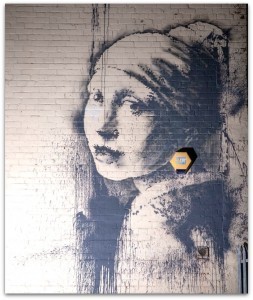 The Girl With A Pierced Ear Drum
The Girl With A Pierced Ear DrumBanksy is one of the most beloved, and elusive, artists out there. Not everybody loves the mysterious street artist, though. In 2014, he painted a large parody of the iconic masterpiece The Girl With the Pearl Earring on a wall in his hometown of Bristol. In place of the earring? An annoyingly loud security alarm. Unfortunately, mere hours after the paint dried, vandals attacked the mural and covered it in black paint.
ISIS vs. Art
In February, the militant group released a video of its soldiers smashing priceless statues in northern Iraq’s Mosul Museum. Amr al-Azm, a Syrian anthropologist and historian, called the incident “a tragedy and catastrophic loss for Iraqi history and archaeology beyond comprehension.” An unidentified man in the video claimed that the statues were sacrilegious and were once worshipped by ancient people instead of God, thus the decision was made to destroy them.
The Stedelijk Peer
The Stedelijk Museum is one of the most unusual in the world. The Amsterdam institution is shaped like a gigantic bathtub, for one thing, and it houses some pretty weird modern art. This could be the reason why Dutch artist and ex-convict Van Koningsbruggen vowed via email in the 2012 to urinate all over two of its most expensive artworks: a statue by Dan Flavin and a painting by Marlene Dumas. The museum’s administration wasn’t amused by what Van Koningsbruggen later explained was “satire” and had him banned. They considered letting him back in 2015 but the artist told them that he would not only pee on the artwork but that he’d be bringing another convicted criminal along with him, too. This new plan earned him a lawsuit and an indefinite ban from the museum earlier this month.
The post Everyone’s a Critic appeared first on Trivia Books and Facts | Uncle John's Bathroom Reader.
March 13, 2015
3 Bands Who Replaced Their Lead Singer And Became a New Band
Lead singers tend to get all the attention…and cause most of the problems. Result: the band fires their lead singer, gets a new one, and goes in a new direction.
 Rage Against the Machine sold eight million albums in the 1990s despite a very anti-commercial message: their songs frequently espoused socialist and Marxist ideology. The band had a falling out in 2001: singer Zach de La Rocha wanted to keep making its brand of music, while the rest of the band wanted to do a covers album. The two camps parted ways, but Rick Rubin, producer of that covers album, suggested the band hire Chris Cornell of the popular grunge band Soundgarden. The new band called itself Audioslave (which Spin called “one of the dumbest band names in recent rock history”). The music was not the call to arms of Rage Against the Machine, but straightforward rock music. Audioslave ultimately released five albums and scored 11 hit singles.
Rage Against the Machine sold eight million albums in the 1990s despite a very anti-commercial message: their songs frequently espoused socialist and Marxist ideology. The band had a falling out in 2001: singer Zach de La Rocha wanted to keep making its brand of music, while the rest of the band wanted to do a covers album. The two camps parted ways, but Rick Rubin, producer of that covers album, suggested the band hire Chris Cornell of the popular grunge band Soundgarden. The new band called itself Audioslave (which Spin called “one of the dumbest band names in recent rock history”). The music was not the call to arms of Rage Against the Machine, but straightforward rock music. Audioslave ultimately released five albums and scored 11 hit singles.
The British band Oasis is as famous for the constant fighting of members (and brothers) Liam and Noel Gallagher as it is for hits like “Wonderwall.” After numerous public fights, including one backstage at a concern in France in 2009, Noel Gallagher left Oasis for good. Oasis, still a popular group in Europe, announced plans to continue on without Noel (the band’s chief songwriter) as Beady Eye. While all of Oasis’s albums had hit #1 in England, Beady Eye topped out at #3, and couldn’t manage a hit single in the U.K. either.
After a few minor hits in the late 1970s, Adam and the Ants frontman Adam Ant hired manager Malcolm McLaren to do for his band what he had done for the punk band the Sex Pistols: make them famous by making them controversial. Ant, however, had overlooked why McLaren had initially formed the Sex Pistols: to promote his London clothing store SEX. McLaren took on the Adam and the Ants job at the same time he was launching a clothing line based on the punk-meets-pirates look of “New Romantic” bands (such as Adam and the Ants). McLaren then convinced everyone except Adam Ant to quit the band. Then McLaren used them as backing musicians for 15-year-old pop singer Annabella Lwin. The new band, Bow Wow Wow recorded a hit remake of the garage rock classic “I Want Candy.” Controversy was indeed generated, as the video featured Lwin in revealing clothing.
The post 3 Bands Who Replaced Their Lead Singer And Became a New Band appeared first on Trivia Books and Facts | Uncle John's Bathroom Reader.



